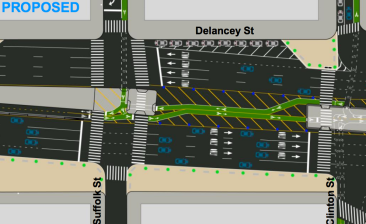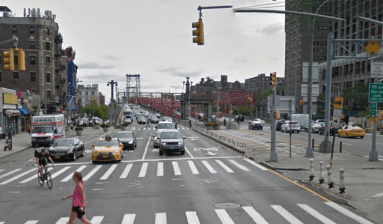Has DOT Decided Against Designing a Safer Delancey Street? [Updated]

Three concrete walls will soon surround the Manhattan entrance to the Williamsburg Bridge, as reported in Gothamist and the Villager. The construction, already underway and due to be completed at the beginning of next year, is part of a Department of Transportation effort to force cyclists coming down the ramp from the bridge to slow down and choose to ride on quieter side roads rather than dangerous Delancey Street, which will remain unchanged.
The redesign of the bridge approach, set in place with concrete barriers and metal fencing, is built to last. Does the project signal that DOT isn’t planning to take action to calm down the deadly traffic on Delancey?
Under the new design, three-foot concrete walls will surround the median at the foot of the Williamsburg bike and pedestrian path. Small gaps in the wall will provide access to crosswalks and bike lanes, but the narrow openings will compel cyclists coming off the bridge to slow down considerably, if not stop completely.

In addition, a curved fence will guide cyclists headed into Manhattan north onto Clinton Street. From there, cyclists can connect to bike lanes on Rivington and Stanton Streets, one and two blocks north of Delancey. Less traffic, slower vehicle speeds, and painted bike lanes make those streets safer to ride on.
In contrast, Delancey is one of the most dangerous streets in the city. A pedestrian and a cyclist have been killed on Delancey already this year, according to Transportation Alternatives, and 134 pedestrians and cyclists were hit by cars on the street between 2008 and 2010.
Helping cyclists find the safest route off the bridge, even nudging them towards that route, is all well and good, but it’s likely that many cyclists will still end up on Delancey. “People want to take the most direct route to where they’re going,” said Caroline Samponaro, the director of bicycle advocacy for Transportation Alternatives. “Even though there are currently markings sending people to use Clinton Street, people continue to use Delancey Street.”
And even if every cyclist detoured onto Clinton, the wide expanse of Delancey would remain a mortal threat to pedestrians. A safety fix for Delancey itself remains necessary, with or without the latest construction at the bridge. The area’s entire political delegation — Assembly Speaker Sheldon Silver, State Senator Daniel Squadron, Borough President Scott Stringer and City Council Member Margaret Chin — have requested that Delancey be made safe for Lower East Siders.
Said a DOT spokesperson over e-mail:
“This railing is being installed to guide bikers to the lanes on Clinton Street – where they can connect to east-west routes – before they reach the crosswalk. A similar design has been in place on the Manhattan side of the Manhattan Bridge for several years and has proven very effective at separating bikes coming off the bridge from pedestrians on the local sidewalk. The concrete barriers are being installed to prevent unauthorized vehicle access to the pedestrian and bike path, and similar steps have been taken on the other side of the bridge and at other East River bridges. Countdown signals were recently installed along Delancey to help pedestrians cross the street safely, while a network of bike lanes has been installed on Suffolk and Clinton streets (north-south), Rivington and Stanton streets (east-west), and on Grand Street (east-west), providing convenient, direct and safer access to and from the bridge for bike riders.”
A redesign of the actual street, not just the approach to the bridge path, would have to grapple with the fact that Delancey Street is overrun with Williamsburg Bridge traffic. Four motor vehicle lanes in each direction lead to and from the untolled bridge, which also sees more bike traffic than any other bridge in the country. “It’s not a unique problem. Every bridge point is a vital, high-demand corridor,” said Samponaro, who pointed to Canal Street and Queens Boulevard as other wide, dangerous roads leading into bridges. Hoping that all pedestrians and cyclists will simply leave Delancey to motor vehicles, however, isn’t a solution. Said Samponaro, “You can’t will people away from a street.”

